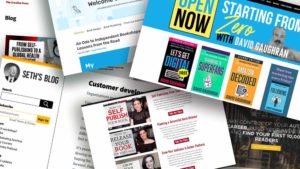An Author Newsletter Readers Will Love (Tips and Examples)

Are you an author looking to build a loyal fan base? Do you dream of the days when the engagement with your community of readers is not only exciting for them but for you as well?
An author newsletter is your key to all that and more!
In this digital age, social media platforms alone are not enough to market a book. Who your posts go to is often out of your control. You’re at the mercy of the social media algorithms and thumb-scrolling, phone culture.
An author newsletter lets you take more control of your fortune and tip the scales in your favor. You choose the layout, and you have direct contact with your readers.
But it’s not as simple as sending an email from your Gmail account.
So, we’re going to guide you through how to make a success of your author newsletter reader journey.
We’ll cover:
- Steps on getting started,
- Ideas for newsletter topics,
- Pro tips to level up your author emails,
- And examples of how to attract your ideal readers to your author newsletter.
What Is An Author Newsletter
An author newsletter is a platform authors use to regularly send emails to readers, fans, and potential fans.
It’s an excellent way to stay connected with your readers and build strong relationships.
The trademarks of author newsletters are usually updates on book writing, new book releases, personal life, and reminders for events, to name a few.
The whole idea is to give your readers an up-close view of your author world and make them become obsessed!
Why You Need an Author Newsletter
In some cases, your social media platforms, and other book promotion tools are enough to have readers flocking to buy your next book. But for most self-published authors or new authors, it’s not that easy.
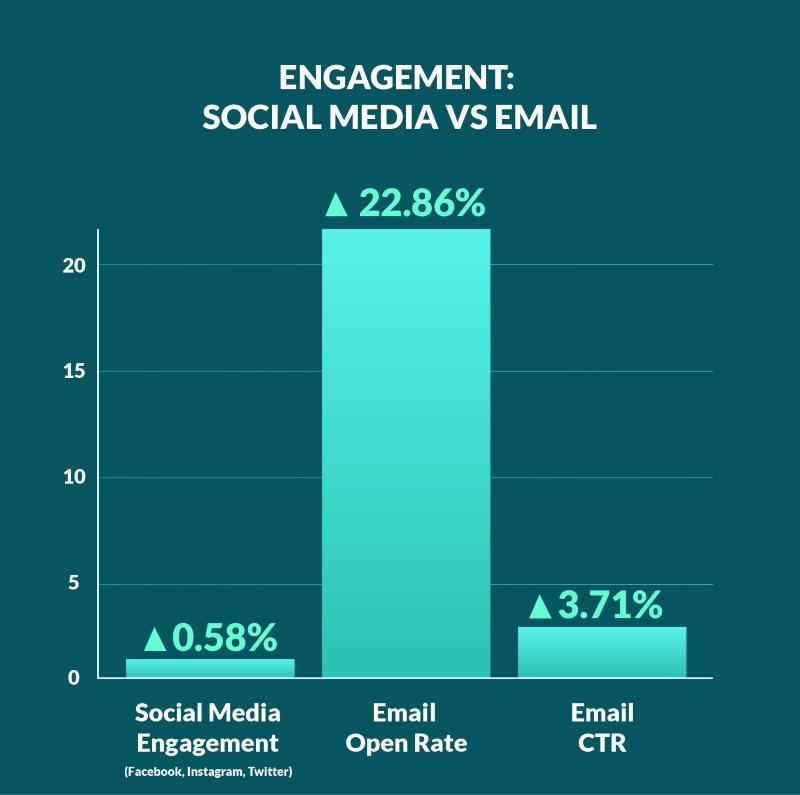
What many authors don’t realize is that the average engagement of social media posts (even by your own followers) is extremely low. Whereas email engagement, when done right, is still extremely high. See the graph above.
To measure how engaged your author newsletter subscribers are, you’ll need to look at email Click Through Rate (CTR). It’s the percentage of people who clicked a link in your email, meaning they were interested enough to see more!
A good author newsletter can consistently achieve open rates of over 22.86%. Compare this to the average social media reach on Facebook and Instagram in 2023 to around 0.58%!
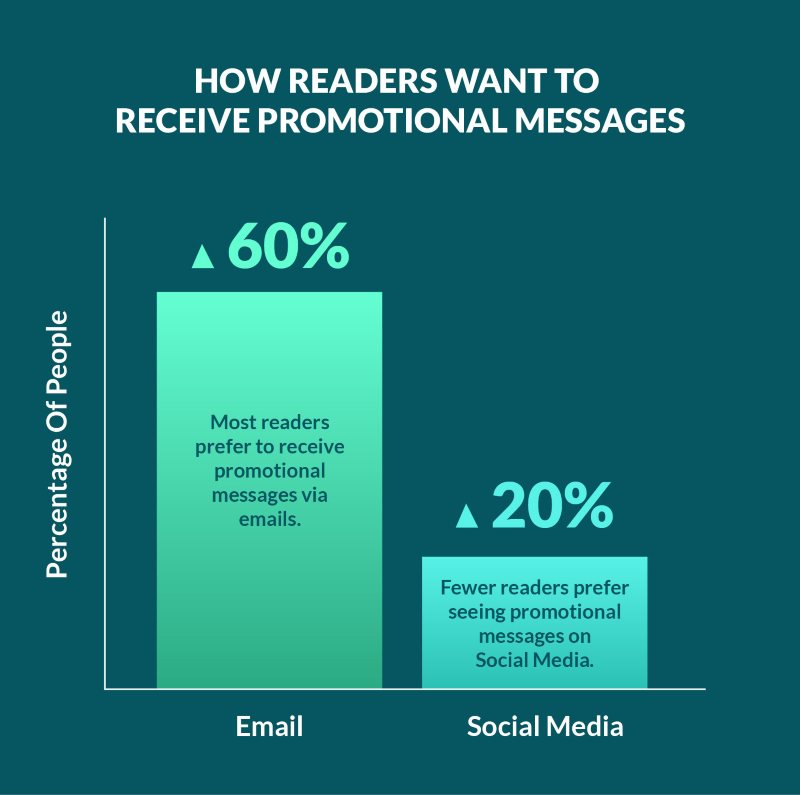
The other thing a newsletter ensures is that you can continue the conversation. Unlike ads or other promotions, you pay virtually nothing to keep sending your subscribers emails.
Plus, most readers prefer to receive promotions in their email inboxes. Much fewer readers prefer to see these promotional materials on their timelines.
Even though email may seem old school, it remains the highest return marketing channel in 2023.
Benefits
A well-planned book launch can help with selling books, but an author newsletter creates an opportunity for long-term book marketing and more book sales.
There are even more benefits to having an author newsletter:
- Solidify your author branding
- Boost your author platform
- Effective tool for book promotion
- Gain more readers
- Feedback on your work from fans
- Turn fans into superfans
- Build connections with new readers faster
Starting Your Author Newsletter
An author newsletter sounds like a fun way to take a break from book writing and engage with your fans, right?
If you’re wondering how to reap those benefits we mentioned, then follow the steps below to give your author newsletter the best chance at success.
- Choose an email service provider
- Pick your reader magnet
- Position your reader magnet
- Frequency of your author newsletter
Choose an email service provider
The right email platform will fit your needs and goals without being too difficult to get the hang of.
However, keep in mind that you won’t feel like an expert using it immediately. It will take some learning in the beginning and that’s normal.
Automation
You want your author newsletters to be personal and customized. But it will be exhausting to sit every week and write an email, not to mention time intensive.
The purpose of an email platform is to help you automate your emails.
Automating your emails will still take effort and time, but it will allow you to schedule your book writing and email writing more efficiently.
How each email platform automates emails will differ slightly, but once you practice you’ll get the hang of it.
Who to choose
When choosing the right author email marketing platform for your author newsletter, you need to consider:
- Costing: A free platform is a great starting point for beginners with low or no subscribers; but paid will grant you access to many more features that could make your life easier.
- Facilities: What automation and features do the platforms have and what will work best for your goals?
These are some of the most well-known email platforms that work well for author newsletters:
- Mailchimp: Beginner to expert level. Free until you reach 500 subscribers.
- MailerLite: Beginner level. Free until you reach 1000 subscribers.
- Campaign Monitor: Beginner to expert level. Free trial to test out features and send test campaigns.
- ConvertKit: Beginner to expert level. Free until you reach 300 subscribers.
- AWeber: Beginner to expert level. Free until you reach 500 subscribers.
- Active Campaign: Intermediate to expert level. Free Trial to test out features.
- Constant Contact: Beginner level. Free trial to test out features.
- Substack: Beginner level. Free but if you turn on paid subscription for your readers, they will take 10% of the revenue for operating costs.
Email domain
Having the right email address is important to the health of your author newsletter. It shouldn’t come from an Outlook, Gmail, or Yahoo account. This may lead to your subscribers deleting the email or worse, it goes into spam!
You want your subscribers to know immediately who the email is from and trust who has sent it.
We suggest creating your own email domain using your author name, for example, firstname@authorname.com.
If you are part of a company, then it will be authorname@companyname.com.
Pick your reader magnet
Next, you must figure out how to get people to sign up for your author newsletter. This is where your reader magnet comes in.
A reader magnet is the author’s version of a lead magnet. This is when you offer something to a reader in exchange for their email address. Because no one wants to randomly sign up for a newsletter without some incentives.
Here’s a list of reader magnet ideas for you to use:
- A cheat sheet or checklist: For example, an author who often advises on relationships puts first-date tips onto a cheat sheet.
- Guides: For example, a fun guide that’s linked to your popular series to entice fans.
- Templates and resources: For example, a lifestyle author provides resources for finding healthy yet tasty snacks.
- Sample: A sample chapter of your most popular book.
- Book: Offer a book for free, which could lead to readers buying the rest of your series (or offer the audiobook version).
- Printable merchandise: For example, a poster or banner for fans to put on their walls.
The trick to a good reader magnet is to know what your target audience would want. If you want to turn readers into fans, you’d need to offer something that gets them started, like a book. If you want to lure fans in then you’d offer guides, resources, or cheat sheets.
Top Tip #1: Be careful of offering too sweet a deal. Too many freebies can lead to more readers signing up, but you may have to deal with more unsubscribes once they’ve collected the freebie.
Position your reader magnet
You have an idea of what you’d like to offer your target audience, but where do you offer it?
The best place to display your reader magnet is on your author website!
Your author website is the hub of all your author activities. Anything and everything related to your work is all in one neat package online for readers and industry professionals to find.
Having the entry point of your author newsletter on your author website is the best way to get visibility on it. This way you also get to control the aesthetics of the sign-up landing pages.
You’ll be able to monitor how well it’s performing and if you need to make changes to entice people to join.
Here are other places to put your reader magnet:
Blogs
Post blogs that your audience would be interested in using your author website. SEO blogging is not as daunting as it sounds. Check our SEO For Authors for an in-depth look at how to use SEO to benefit your author career.
Posting content on your author website that your audience searches for on Google will help drive traffic to your reader magnet. But make sure that the reader magnet is bold and clear throughout your author website. Here’s an example below of how we’ve added it to our blog pages. It’s good to have it at the top of the page because that’s where users land.
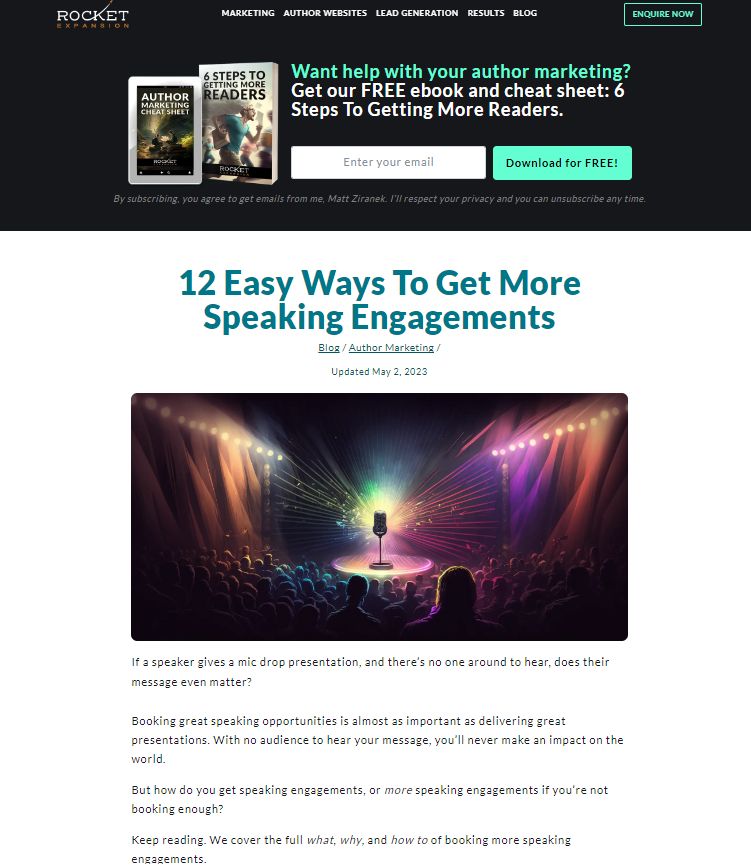
Inside Your Books
Add a link near the front and back of your books for your readers to grab your awesome free stuff and stay connected.
Keep the website link simple so that physical copy book buyers can easily type it. Something like yourwebsite.com/free is probably best.
This way you’ll get some newsletter subscribers through your Amazon sales as well.
It’s also a good way to bring some of your Amazon audience to your newsletter since Amazon doesn’t give you access to their customer email database.
Events
Bring a pen and clipboard to events so you can ask the audience after the event if they’d like to sign up.
Later, you add these names to your author newsletter email list.
Social Media
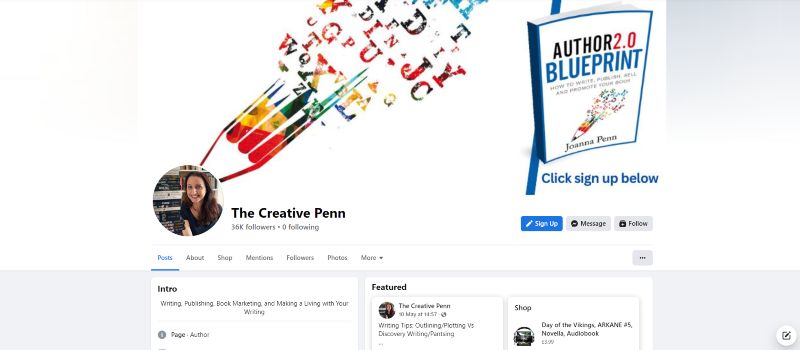
Post it on your Facebook Author page, Twitter, Instagram, Pinterest, and LinkedIn to get your followers to join your author newsletter.
For example, J.F. Penn’s brand called The Creative Penn has a nice page on Facebook to attract her audience to sign up for her newsletter.
Make use of hashtags on these platforms to your advantage! Look up what hashtags are used by your target readers and put those in your posts to attract readers to your author newsletter.
Book promotion sites
You should include your author newsletter magnet in your bios or posts on Goodreads, BookBub, etc.
These platforms are book-centric, meaning your ideal readers are there waiting to be found!
Paid Ads
Depending on your target audience, Facebook and Google Ads could be beneficial in attracting readers to your author newsletter. This form of paid advertising works well for authors because you’re paying these data-rich platforms to put your stuff out to specific audiences.
You may think it’s annoying to get those insurance ads on your feed. But, in your case, you’ll be advertising cool book-related offers to readers.
Which reader wouldn’t love to see new authors in their preferred genre popping up on their timeline?
Other Media
Mention your author newsletter during podcasts, guest posts, and interviews, for example.
If you’re doing blog tours leading up to a book release, it’s a great opportunity to get 2 birds with one stone: book marketing and promoting your author newsletter.
Frequency of your author newsletter
You now have your offer set, next is deciding how often you’d like to send your author newsletter.
Think about how much time you’d like to spend on it and how often your readers would want the content.
If you’d like to send longer author newsletters, then you should send them monthly so your readers don’t feel overwhelmed by your emails.
If you want to do shorter author newsletters, then anywhere from twice a week to once every 2 weeks should work for your readers.
Send it too often and you’ll land your author newsletter in the spam folder. Don’t send it often enough and the reader will forget they even subscribed to your author newsletter.
Author Newsletter Examples of Sign-ups
After you’ve mapped out some logistics for your author newsletter, you need to get your landing pages and reader magnets up and running.
We’ve put together some screenshots of our examples in different genres to cover any type of author newsletter magnet. See below for author newsletter examples for sign-up landing pages.
Side note: We have a small confession to make. All these author newsletters are from authors we’ve built websites for. We love showcasing our authors’ work!
Sci-Fi author newsletter example
Daniel Gibbs
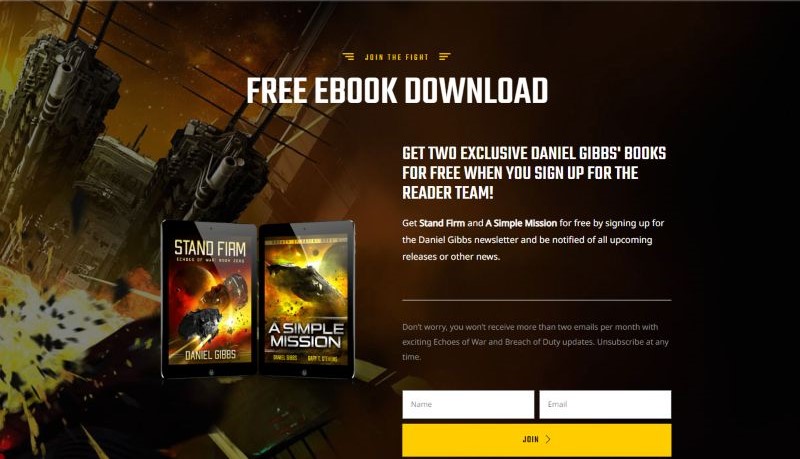
Daniel Gibbs’ Military Sci-Fi landing page is all style and all substance.
He offers 2 free books and makes it very clear that you will not be bombarded with emails.
Thomas Weaver
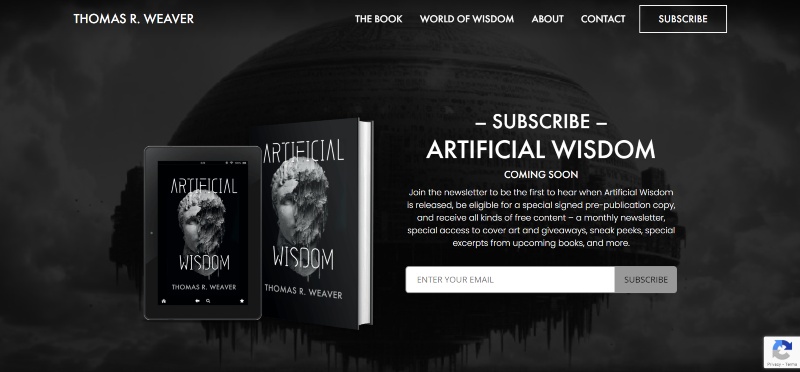
When you have a book on the way, you can sweeten the deal by offering a special signed copy to join your author newsletter.
Thomas also promises some nice content in the form of book cover art, giveaways, sneak peeks, and special excerpts.
Romance author newsletter example
K.C Ale
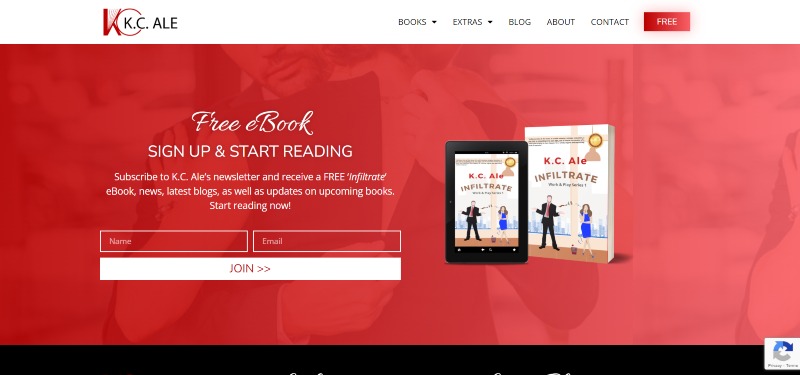
K.C Ale’s author newsletter puts faith in her Infiltrate novel being the gateway to subscribers buying more books and keeping readers hooked.
The landing page is vibrant and jumps out at you in the best ways.
Maggie Carpenter
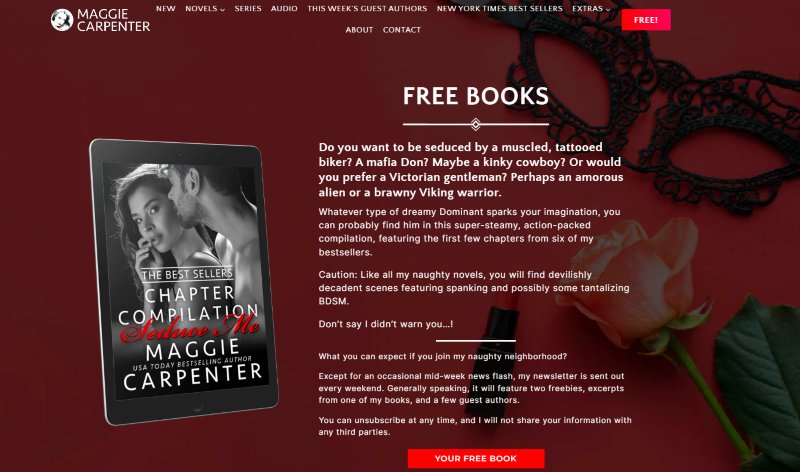
Maggie’s author brand comes across strongly on this author newsletter reader magnet. She sells on offers as well as personality.
She makes it very clear what you’re signing up for which will reel in her ideal readers immediately.
Fantasy Author Newsletter
Davis Ashura
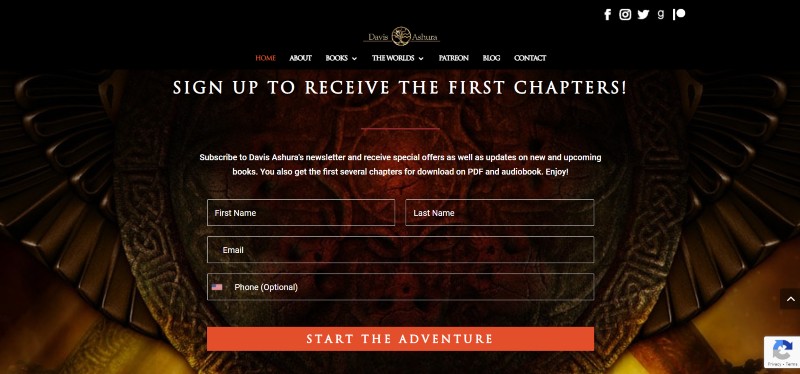
Simple, engaging, and effective. That’s what Davis Ashura goes for here. He prioritizes selling his books, so he promises to share several chapters of his books in PDF and audiobook form.
This is a great example of a book-focused author newsletter example.
Kate Jones
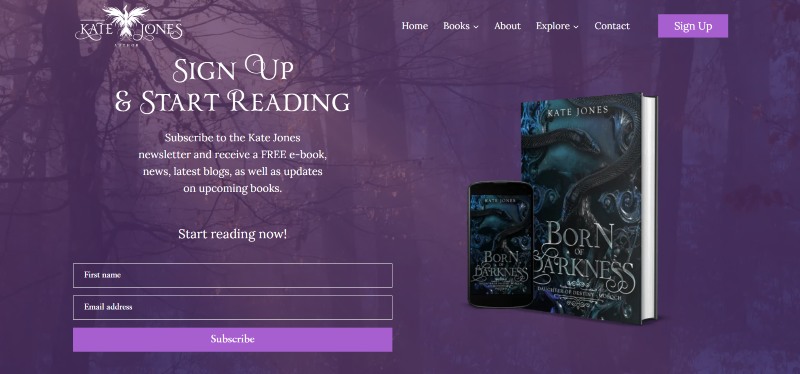
This is another author newsletter example on book-focused content. You get the sense that this is an author who has been pumping out work.
Readers will be excited to know that there’s so much to discover and read!
Children’s Author Newsletter Example
Miki Taylor
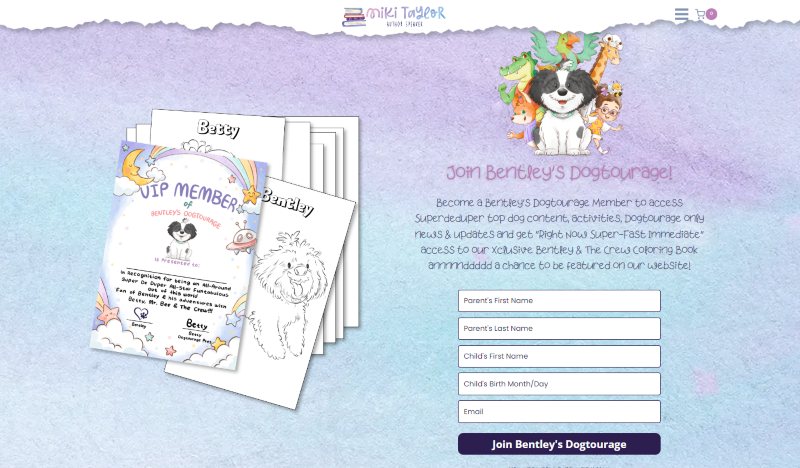
A children’s author newsletter example that’s playful and offers a ton…what’s not to love?
Besides a super cool color book offer, you’ll stand a chance to be in the author newsletter. This is a great way to engage with children!
Valencia Weaver
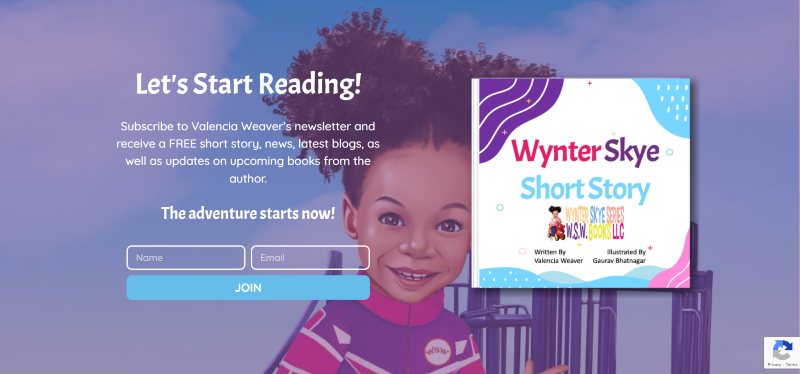
The Wynter Skye series is one Valencia wants readers to fall in love with. There’s no better entry point than a free short story!
Thriller Author Newsletter Example
Tim Sullivan
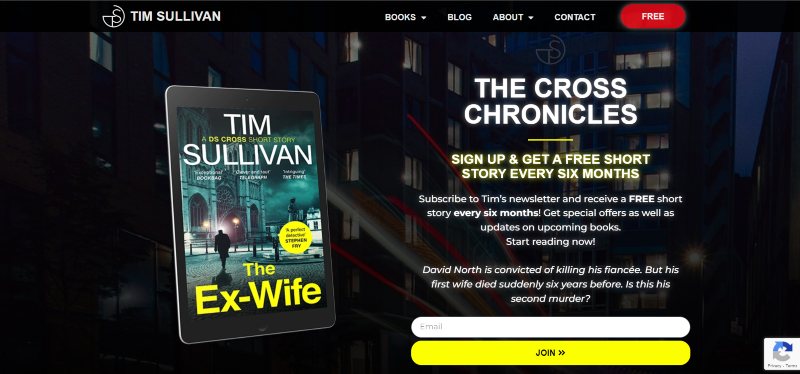
Free short stories every 6 months in exchange for an email address? What a deal!
A nice touch on this landing page is the little synopsis of the first short story is about, which will surely get readers excited to sign up.
Andrew Clawson
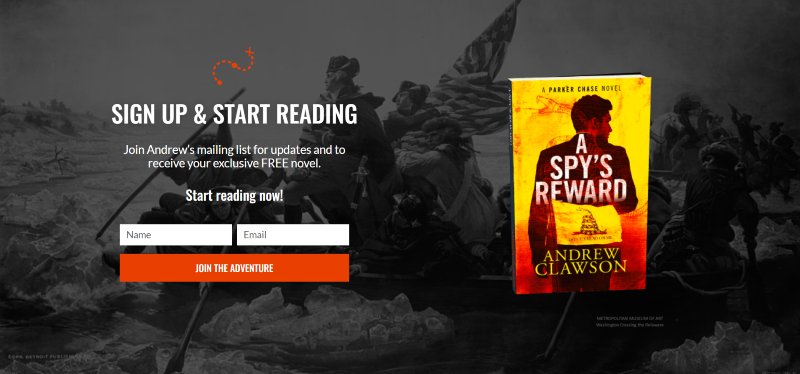
Another simple yet engaging example of how to attract your readers. A free novel about spies? Readers who love this genre will definitely be interested.
Nonfiction Author Newsletter Example
Fran Severn
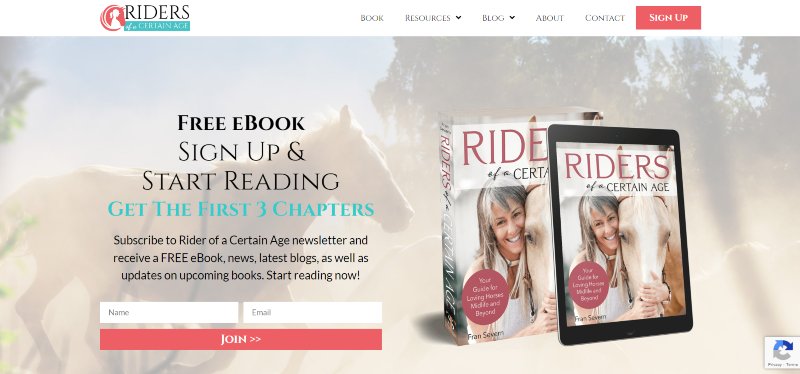
Sometimes it just doesn’t benefit you to give the whole book away for free. In Fran’s case, she shares the first 3 chapters.
Couple the offers with a pleasing background, and the right readers will be on the doorstep of your email list.
Steve Braverman
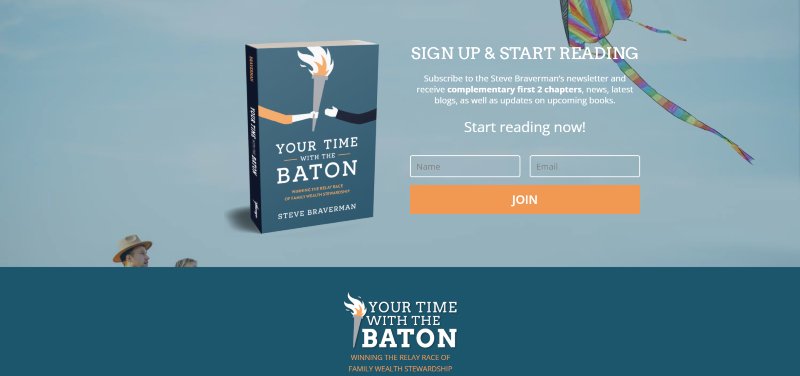
Just like the example above, it will work best to center your offers around your main works. That’s what Steve has done.
Instead of spreading yourself thin and offering a lot of content, try and usher your subscribers through your book funnel so they will be closer to buying your book.
Multi-Genre Author Newsletter Example
Austin Dragon
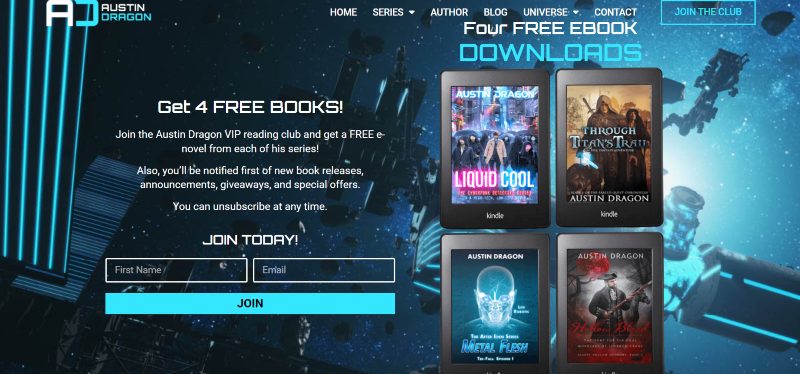
When you’re a jack of all trades like Austin, one free book may not cut it. If you want your readers to fall down the rabbit hole, you have to give them a good ol’ nudge.
Doctor’s Lane
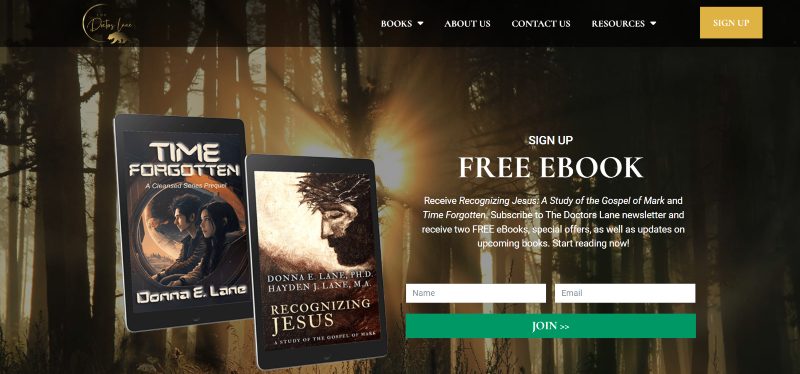
Once again, one book isn’t enough to showcase all your capabilities.
The Doctors Lane uses the same strategy to entice readers to make the leap and become fans. All you need to do is subscribe.
Author Newsletter Ideas
Next up, you need to know what your author newsletter will be about. Fans and potential readers won’t appreciate you only sending emails to promote your books.
There are 2 factors to consider:
- Your author brand: What do you want to be known for and what do you want your subscribers to understand about you through your author newsletters?
- Content: What type of content would interest you and your target audience?
If you’re stumped for ideas, we’ve got your back. Here’s a list of author newsletter ideas you could use:
Updates
Fans want to know what’s going on in your world, whether it’s on a personal level or about your books. They’ll get more insight into who you are, and it will form a stronger impression of your author brand.
- Updates on your books: progress on writing books, book awards, book teasers, book trailers, etc.
- Book Press Releases: Let your subscribers know what’s going on with your new book release and where it can be purchased.
- Personal life: Share as much of your life as you’re comfortable with and keep in mind your author brand (milestones in your life are the safest bet that still creates a personal bond with your readers without revealing too much about yourself).
Gateway to other content
Use your author newsletter to reel your audience into other content you have produced.
- Your blogs: Share what you’ve posted on your blog in your author newsletter (it drives traffic to your website too!)
- Guest blogs: If you’ve featured on someone’s blog, make sure to add that to your newsletter to keep your fans in the loop and get the blog some attention.
- Your socials: Link your social media platforms and discuss interesting posts to keep all your fans engaged on all platforms.
- Interviews: Talk about interviews you’re doing and provide links to them (this could be for podcasts, articles you’re in, and YouTube or TV interviews).
- Company-related: If you’re part of a company, link to news, blogs, and articles related to the organization.
Bonuses
Sometimes you’ll want to reward your audience for their loyalty and provide them with some bonus content that they won’t find anywhere else!
- Exclusive content: Discuss insider information about your books or industry and give away more freebies, sample chapters, deleted scenes, prequels, epilogues, signed copies, etc.
- Contests: Host giveaways and competitions to receive a free book or merchandise to create buzz around your work.
- Sales: Have flash sales for your books, boxsets, courses, and merchandise; it not only makes their stay on your author newsletter more rewarding, but it promotes your work too!
- Author newsletter content: Write mini-stories and articles specifically for your newsletter.
- Exclusive reveals: Book cover design, book title, and main character reveals for upcoming books
Here’s an example of a fun book cover reveal by Susan Dennard.
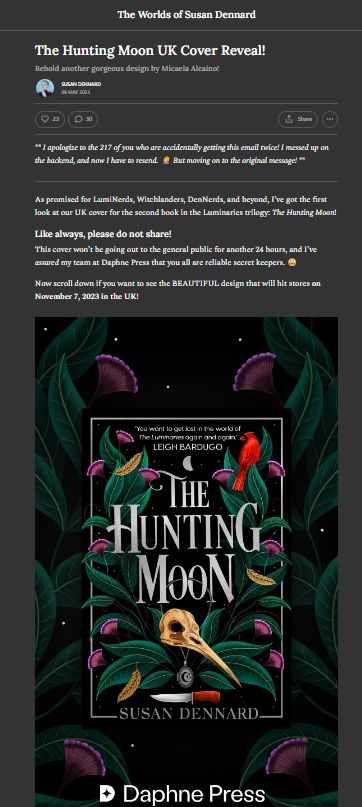
Behind The Scenes
Use your author newsletter to give your subscribers a behind-the-scenes look at your books.
- Research: Reveal the research you’ve done for book locations, characters, etc., and show off photos that inspired scenes in your book.
- Behind the story: Show your subscribers the story behind parts of your book and why it was written that way.
- Influences: Share your appreciation for art or other books that inspired your own work.
Recommendations
Use your author newsletter to recommend what you like and also showcase reviews of your own books.
- Books: Recommend other authors’ work. This is a great way to support others in your industry.
- Podcasts: Depending on your author platform and your audience’s interests, share podcasts that you know they’d love.
- Television: If you’re lucky enough to get your book made into a TV show or movie, it may be nice to share recommendations in the same genre leading up to your own release.
- Book reviews: Share reviews of your books from fans to entice subscribers to click that purchase button.
- Alpha readers and Beta readers: You can also use your author newsletter to reach out and find alpha and beta readers to read your book and give you feedback in the earlier stages of book publishing.
Books On Gif is a great newsletter for book recommendations. You can see below that they encourage discussion with their community too!
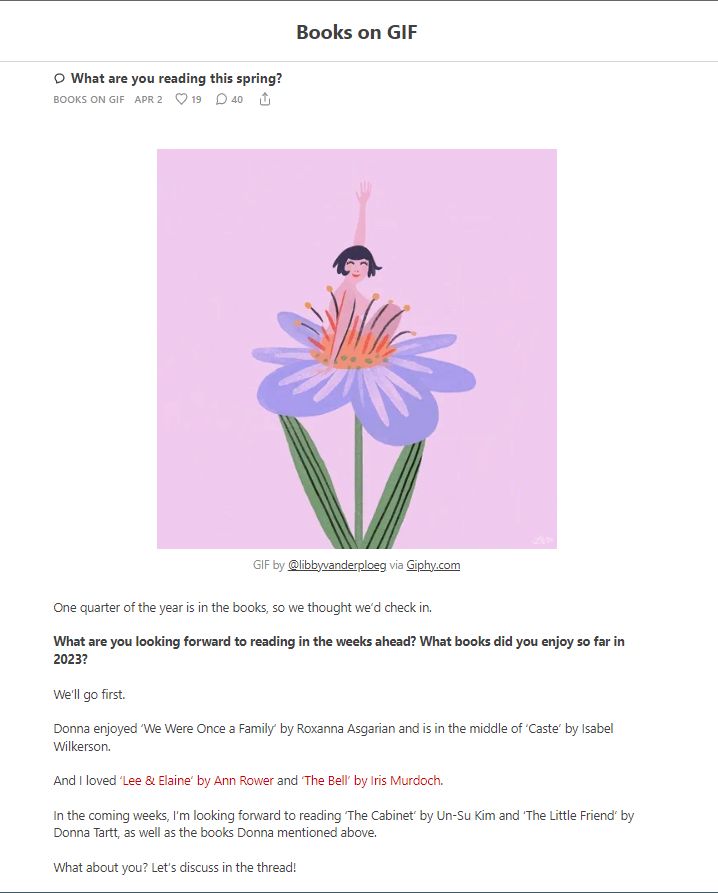
Events
You want your die-hard fans cheering you on when you’re talking at events. To make sure they come out to see you, notify them using your author newsletter. And don’t forget to recap events afterward to share your experiences.
Here are some events you could feature in, and that you should document in your author newsletter:
- Book signings
- Speaking Engagements
- Conventions
- Workshops
- Book launch parties
Get to know you
Show your audience a more personal side.
- Q&As: Ask subscribers to submit their burning questions through your author newsletter and you can answer them once a week or month.
- Writing advice: If your subscribers consist of writers, then share advice and other helpful information that relates to writing and publishing.
- Other advice: Consider the interests of your audience and give them advice surrounding those topics; for example, advice on work-life balance.
- Creative process: Share your writing process and how you get books written.
For example, Ann Handley’s ‘You ask, I answer’ column.
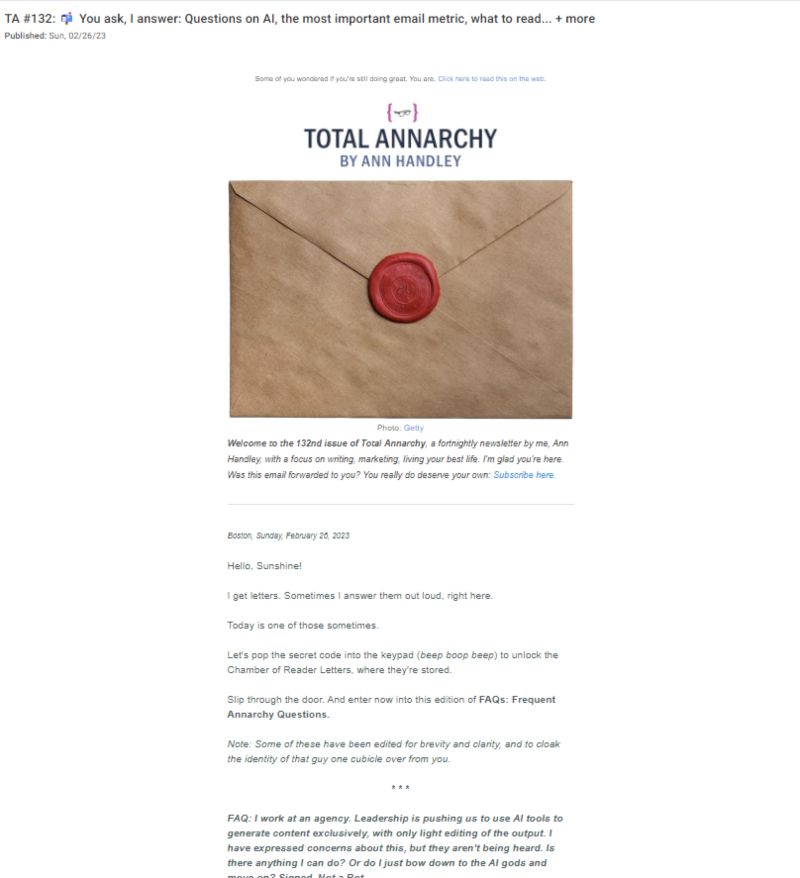
Out the box
Here are a few extra author newsletter ideas to help you find the best content for yours:
- Holidays: Have certain editions of your author newsletter centered around holiday themes.
- Anniversaries: Share memories about book anniversaries, have a flash sale, or have a giveaway for a special edition for author newsletter subscribers only.
- Expertise: Use your unique perspective and expertise to give facts and advice on topics in your niche.
- Puzzles: Create and share puzzles that will engage your readers.
- Downloadable content: You can create coloring pages (this works well for children’s authors), templates, worksheets, etc.
- News: Discuss events and news surrounding your books’ themes.
- Character’s voice: Write an author newsletter from the perspective of one of your characters.
- Artwork: Share artwork from fans (they can submit it to the author newsletter or on social media); they’ll be excited to see you appreciate their art.
- Survey: Sometimes you need to hear what your subscribers have to say; you can ask them what they love about your author newsletter or what they’d like to see.
Optimizing Your Author Newsletter
To have your author newsletter stand out from the crowd, you need to optimize it to provide the best experience possible for your subscribers. Here are a few pointers you can use to get you started.
Authenticating subscribers
We live in the age of the internet where bots and hackers are common. To stop these nuisances from subscribing to your author newsletter, use authentication on your sign-ups.
Some email platforms allow you to use double opt-ins which can weed out the bots. In other cases, reCAPTCHA is great for stopping those bots in their tracks.
Welcome Email
You need a welcome email to grace readers’ inboxes once they’ve signed up. This should contain your reader magnet offer and what they can expect from your author newsletter.
Remember to review this email once a year to make sure the copy is fresh and relevant.
We like how K.C. Ale’s first email is to the point (we may be biased since we designed her website). Here’s an example of what your welcome email can look like if you’d like to keep it strictly offer-related:
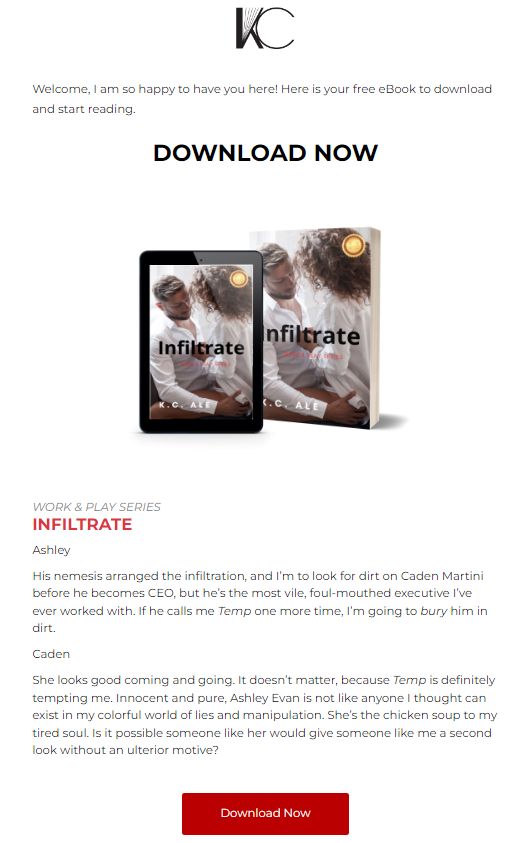
Onboarding
Depending on your author newsletter goals, you may not need to have an onboarding process for your author newsletter.
An onboarding process would be all your best emails and content to make your subscribers glad they joined your list.
This gives them a taste of what your author newsletter is made of and will help you maintain subscribers and lower unsubscribe rates.
Subject Lines and Preheader
A boring subject line and preheader text that doesn’t hint at what’s in the email will send your author newsletter straight from the inbox to the bin.
Your subject line and preheaders should be unique and interesting without being too long.
And your preheader text should complement your subject.
Here are 2 examples of engaging subject lines and preheaders:
- Subject: Book Series Names Deal
- Preheader: Up to 50% off
- Subject: Book Name Release Date Announcement!
- Preheader: New edition to the family
Be Consistent
You may get excited to share your book release news or life milestones, but do not overwhelm your readers with too many emails!
Keep your author newsletter as consistent as possible with the schedule, and also make sure to keep font styles and sizes standard. No one wants to look at a busy author newsletter that’s busy with too many designs and styles.
Unsubscribing
You need to include an unsubscribe link at the bottom of your emails to comply with the laws of email marketing.
Besides what’s legal, you don’t want to be spending money on an email platform to maintain an email list with people who don’t even want to be there!
Let them off your author newsletter. Your open rate will thank you!
Top Tip #2: People will eventually leave your author newsletter. It’s the circle of life! Perhaps they’ve already bought your books or maybe they never planned on buying your books. In either case, you’ve done your best and it’s okay to see these readers go.
Re-engagement Email
In some cases, you may need to fight to keep your subscribers. Time to give your less active subscribers an ultimatum with a re-engagement email.
This email is about asking the subscribers to make a decision: Stay on the author newsletter by clicking a link or replying to the email, or ignore it and they will be automatically removed.
Top Tip #3: The subject should be eye-catching to make sure they open it.
Testing your author newsletter
If you’re seeing a spike in unsubscribes, or readers stop opening your emails as much, it’s time to get testing!
See what works and what doesn’t; play around with which days and times you send your author newsletter.
Also, you could send a survey to see what the readers think and adjust your author newsletter to their interests.
Maybe your subject lines are not engaging enough. To figure that out, do some A/B testing where you choose 2 different subject lines and see which subject line gets the most opens.
Promoting your author newsletter
Once you’ve started promoting your author newsletter, don’t stop! You want to build an awesome community of your ideal readers so never stop pushing your author newsletter.
Top Tip #4: Segment your audiences based on where they’ve signed up from. Create different audiences on your email marketing platform and use this to make more customized emails. To do this, start with duplicating your landing pages for author newsletter sign-ups from different platforms.
Evergreen author newsletter
Once you’ve been at the author newsletter game for a while, you’ll have racked up some killer emails.
It’s time to group those emails into an evergreen author newsletter.
An evergreen author newsletter runs automatically beside the content you curate every month.
You could use it to help you put out your author newsletter during your busy periods when you’re trying to crank out pages for your next book.
New subscribers won’t know you’ve used the content before! And unless you have some obsessed fans, they probably won’t remember them!
Do’s and Don’ts of Author Newsletters
There are a few more tips we’d like to share that will make your author newsletter immaculate!
Author newsletter Do’s:
- Do use pop-ups sparingly on your website for sign-ups, if there are too many the user will likely exit your author website immediately.
- Do use instructions given by the email platforms to embed sign-up boxes efficiently.
- Do keep the same layout and formatting in all your author newsletters.
- Do add links to your social media, author website, and book links to your email footer.
- Do include your business address or PO Box at the bottom of your emails to comply with relevant marketing laws.
- Do keep exclamation points to a minimum, it can come off as too excitable!
- Do avoid spam trigger words
- Do subscribe to author newsletters to see how others curate theirs and to understand the perspective of the subscriber (see examples below).
- Do thank your subscribers for their loyalty with extra offers and shoutouts.
Author newsletter don’ts:
- Don’t add anyone to your list without permission.
- Don’t use too many topics in your author newsletter, you’ll overwhelm your readers.
- Don’t only send marketing emails; strike a balance of personal and promotion.
- Don’t add too many links to the body of your emails, use 1 link multiple times to avoid the spam folder.
- Don’t use too many CTAs, use 1 CTA to keep the email clear and concise.
- Don’t forget to edit and proofread your author newsletter.
- Don’t use all CAPS in your copy, IT LOOKS LIKE YOU’RE SHOUTING AT THEM
- Don’t forget to improve your copy of landing pages and welcome emails every 6 months to a year.
Best Author Newsletters
If you’re itching to see what others have done, check out these author newsletters.
Rocket Expansion
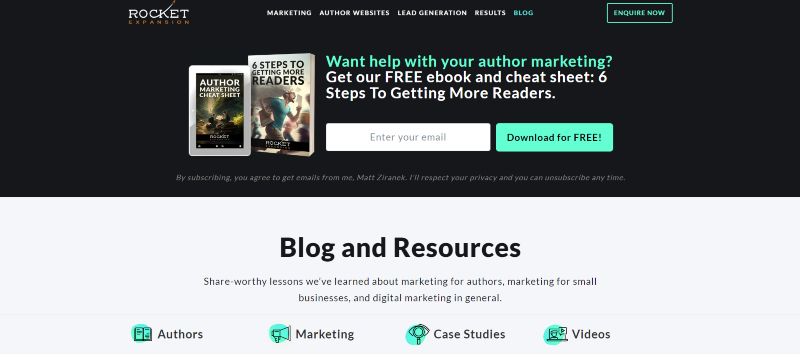
We’re technically not an author newsletter, but all our content relates to authors!
We showcase the author websites we’ve launched to help authors with inspiration and give author marketing advice.
Jane Friedman – The Hot Sheet
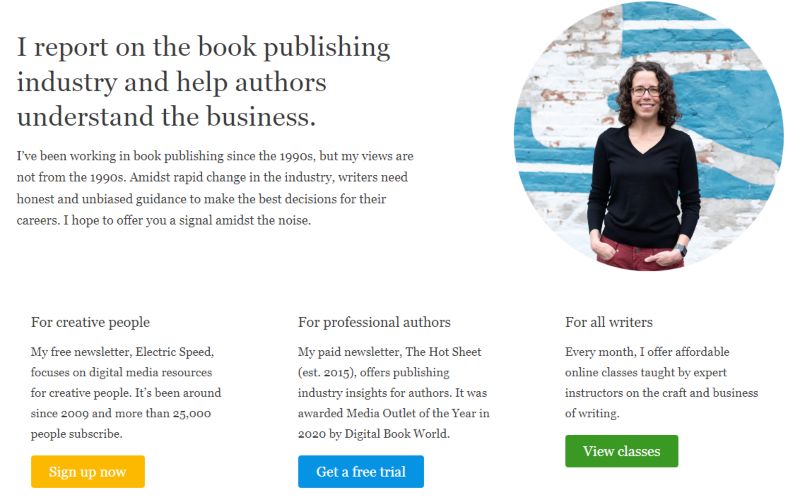
Jane Friedman is revered in the author community for her author marketing advice and insights into the world of publishing.
Definitely worth trying the free trial or her free author newsletter called Electric Speed.
Ann Handley – Total Annarchy
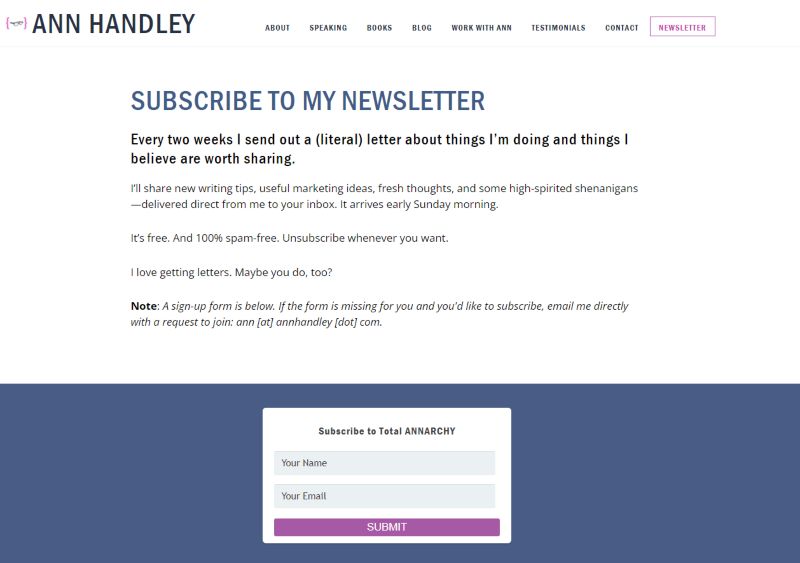
Ann Handley is a best-selling author who gives digital marketing advice for writers. She takes a light-hearted spin on writing and content creation which makes for easy reading.
Kate McKean – Agents and Books
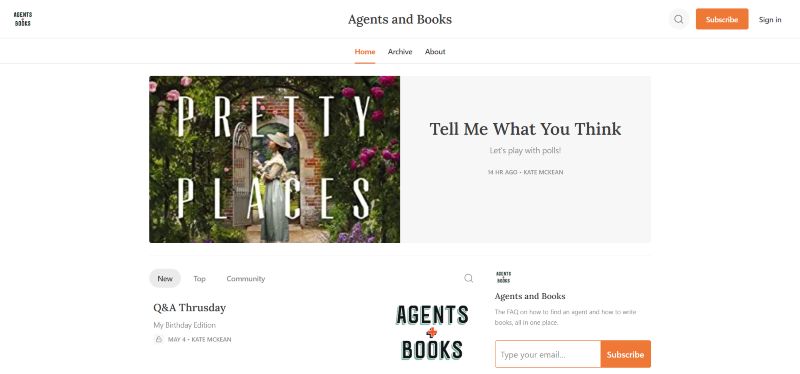
Need advice on finding agents and getting your books written? Well, that’s Kate McKean’s specialty!
She has a free author newsletter as well as a paid one with Q&As. Getting inspired to rock the author industry has never been easier.
Roxane Gay – The Audacity
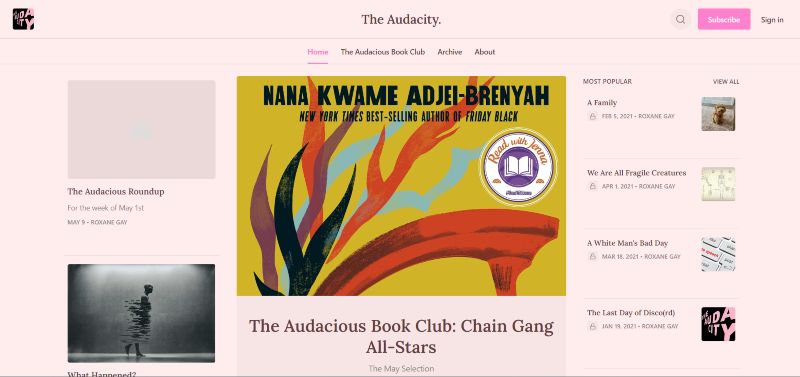
If you want to learn about how to do your author and personal life updates over email, then Roxane’s author newsletter is right up your alley.
She mixes book club discussions, her own writing, and featured essays from other writers to make quite an engaging author newsletter.
Austin Kleon
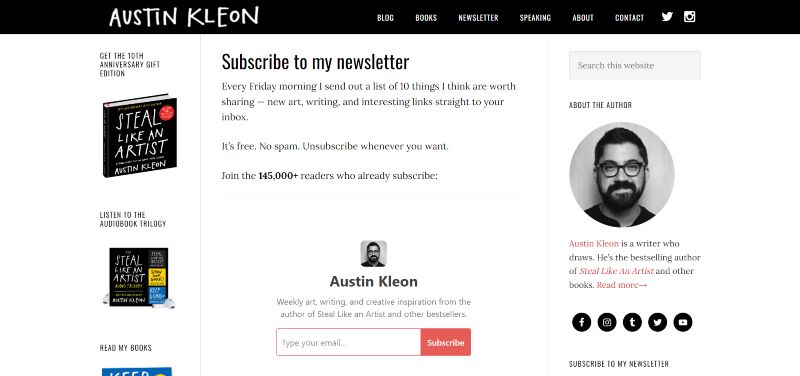
Want to see recommendations done right? Austin Kleon’s author newsletter is a great example.
He frequently sends out a list of recommendations for reading, watching and listening that would interest creative people.
Jami Attenberg – Craft Talk
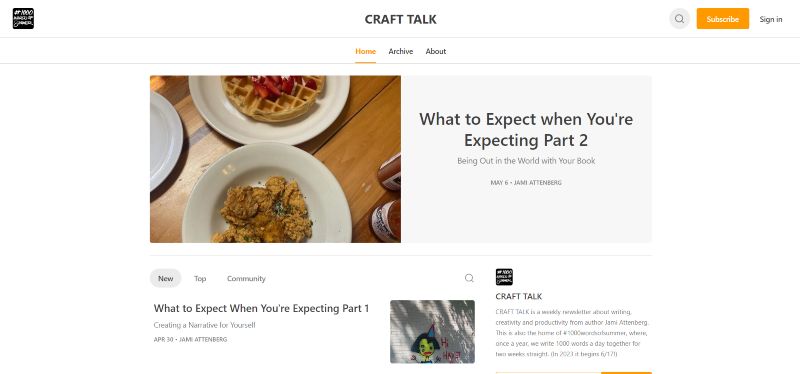
Another great author newsletter for insights into an author’s writing experience and personal life.
Want some author upliftment? Craft Talk is where it’s at.
Author Newsletter: Final Words
There are so many authors out there, making it harder to stand out and build a strong community of fans.
Having an author newsletter makes it much easier to garner a following that will become interested in your work.
With some time and effort, your author newsletter will be capturing emails and taking names. You’ll be producing high-quality, valuable content that makes subscribers want to buy your books!
But the first step in housing your epic author newsletter is having an author website!
It’s the perfect place for your books, blogs, and author newsletter. When it’s done right, it’s beautiful, loads fast, and easy to maintain.
Luckily, we know exactly how to do it right. We know that author newsletters and author websites go hand in hand.
We’re ready to help you shine online. Just fill in this inquiry form and you’re one step closer to your loyal community.
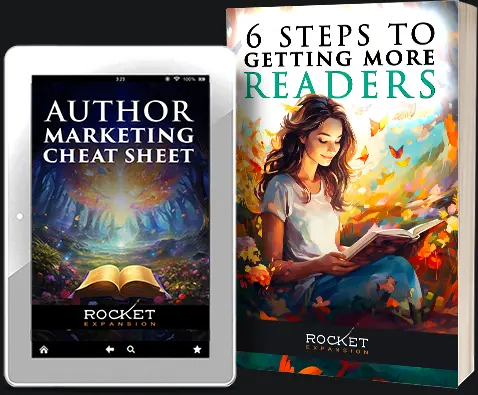
Want help with your author marketing? Get our FREE ebook and cheat sheet: 6 Steps To Getting More Readers.
By subscribing, you agree to get emails from me, Matt Ziranek. I’ll respect your privacy and you can unsubscribe any time.
